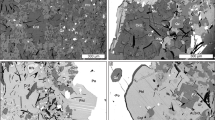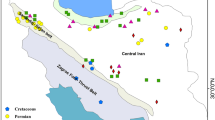Abstract
This article proposes a new integrated methodology to determine the mineralogical composition of silt-sized sediments, reaching the same precision level required to perform quantitative provenance analysis as traditionally done on sand-sized sediments. We examine technical problems encountered in analysis of silt and illustrate how they can be solved for suspended load in a modern fluviodeltaic environment. All methods described here, and specifically the user-friendly Raman spectroscopy, can be routinely applied in mineralogical studies of ancient siltstones. Provenance information can thus be extracted from mudrocks, which represent a very conspicuous part of the stratigraphical record and are prone to preserve original detrital assemblages from diagenetic dissolution better than permeable interlayered sandstones. Quantitative mineralogical analysis of silt-sized sediments by innovative techniques opens up new frontiers in sedimentary petrology. Such an effective approach is of crucial importance to make accurate provenance diagnoses and sediment budgets and to correctly unravel the innumerable pieces of geological information stored in sedimentary archives from the alluvial plain to the deep-sea.






Similar content being viewed by others
References
Allison MA, Khan SR, Goodbred SL, Kuehl SA (2003) Stratigraphic evolution of the late Holocene Ganges–Brahmaputra lower delta plain. Sedim Geol 155:317–342
Assallay AM, Rogers CDF, Smalley IJ, Jefferson IF (1998) Silt: 2–62 μm, 9–4φ. Earth-Sci Rev 45:61–88
Berman R (1953) A nomogram for obtaining per cent composition by weight from mineral-grain counts. J Sediment Petrol 23:120–123
Bersani D, Lottici PP, Montenero A (1999) Micro-Raman investigation of iron oxide films and powders produced by sol-gel syntheses. J Raman Spectros 30:355–360
Bersani D, Andò S, Vignola P, Moltifiori G, Marino IG, Lottici PP, Diella V (2009) Micro-Raman spectroscopy as a routine tool for garnet analysis. Spectrochim Acta A 73:484–491
Blatt H (1985) Provenance studies and mudrocks. J Sedim Res 55:69–75
Blatt H, Jones RL (1975) Proportions of exposed igneous, metamorphic, and sedimentary rocks. Geol Soc Am Bull 86:1085–1088
Blatt H, Sutherland B (1969) Intrastratal solution and non-opaque heavy minerals in mudrocks. J Sedim Petrol 39:591–600
Chayes F (1954) The theory of thin-section analysis. J Geol 62:92–101
Curray JR, Emmel FJ, Moore DG (2003) The Bengal fan: morphology, geometry, stratigraphy, history and processes. Marine Petrol Geol 19:1191–1223
Dickinson WR (1970) Interpreting detrital modes of graywacke and arkose. J Sedim Petrol 40:695–707
Fan PF (1976) Recent silts in the Santa Clara river drainage basin, southern California; a mineralogical investigation of their origin and evolution. J Sedim Res 46:803–812
Freeman JJ, Wang A, Kübler KE, Jolliff BL, Haskin LA (2008) Characterization of natural feldspars by Raman spectroscopy for future planetary exploration. Canadian Min 46:1477–1500
Galehouse JS (1971) Point counting. In: Carver RE (ed) Procedures in sedimentary petrology. Wiley, New York, pp 385–407
Galy V, France-Lanord C, Beyssac O, Faure P, Kudrass H, Palhol F (2007) Efficient organic carbon burial in the Bengal fan sustained by the Himalayan erosional system. Nature 450:407–410
Garzanti E, Andò S (2007) Heavy-mineral concentration in modern sands: implications for provenance interpretation. In: Mange MA, Wright DT (eds) Heavy minerals in use. Developments in Sedimentology Series, vol 58. Elsevier, Amsterdam, pp 517–545
Garzanti E, Vezzoli G, Andò S, France-Lanord C, Singh SK, Foster G (2004) Sand petrology and focused erosion in collision orogens: the Brahmaputra case. Earth Planet Sci Lett 220:157–174
Garzanti E, Doglioni C, Vezzoli G, Andò S (2007a) Orogenic belts and orogenic sediment provenances. J Geol 115:315–334
Garzanti E, Vezzoli G, Andò S, Lavé J, Attal M, France-Lanord C, DeCelles P (2007b) Quantifying sand provenance and erosion (Marsyandi River, Nepal Himalaya). Earth Planet Sci Lett 258:500–515
Garzanti E, Andò S, Vezzoli G (2008) Settling equivalence of detrital minerals and grain-size dependence of sediment composition. Earth Planet Sci Lett 273:138–151
Garzanti E, Andò S, Vezzoli G (2009) Grain-size dependence of sediment composition and environmental bias in provenance studies. Earth Planet Sci Lett 277:422–432
Garzanti E, Andò S, France-Lanord C, Censi P, Vignola P, Galy V, Lupker M (2011) Mineralogical and chemical variability of fluvial sediments. 2. Suspended-load silt (Ganga-Brahmaputra, Bangladesh). Earth Planet. Sci Lett 302:107–120
Gazzi P (1966) Le arenarie del flysch sopracretaceo dell’ Appennino modenese: correlazioni con il flysch di Monghidoro. Miner Petrogr Acta 12:69–97
Geiger CA (2008) Silicate garnet: a micro to macroscopic (re)view. Am Min 93:360–372
Hay WW (1998) Detrital sediment fluxes from continents to oceans. Chem Geol 145:287–323
Hering OH, Zimmerle W (1963) Simple method of distinguishing zircon, monazite, and xenotime. J Sedim Res 33:472–473
Hunter RE (1967) A rapid method for determining weight percentages of unsieved heavy minerals. J Sediment Petrol 37:521–529
Ingersoll RV (1990) Actualistic sandstone petrofacies: discriminating modern and ancient source rocks. Geology 18:733–736
Kellagher RC, Flanagan FJ (1956) A comparison of two methods for converting grain counts to weight percent composition. J Sediment Petrol 26:222–227
Kübler KE, Wang A, Abbott K, Haskin LA (2001) Can we detect carbonate and sulphate minerals on the surface of Mars by Raman spectroscopy? Lunar Planet Sci 32, Abstract #1889
Larson AC, Von Dreele RB (2000) General structure analysis system (GSAS). Los Alamos National Laboratory Report, LAUR, pp 86–748
Lee JI, Clift PD, Layne G, Blum J, Khan AA (2003) Sediment flux in the modern Indus River inferred from the trace element composition of detrital amphibole grains. Sedim Geol 160:243–257
Lupker M (2011) Quantification de l’altération passée sur les sédiments détritiques et géochimie des fleuves du bassin himalayen (Gange, Brahmapoutre). PhD Thesis, CRPG Nancy
Mange MA, Maurer HFW (1992) Heavy minerals in colour. London, Chapman and Hall, p 147
McKeown DA (2005) Raman spectroscopy and vibrational analyses of albite: from 25°C through the melting temperature. Am Min 90:1506–1517
Mernagh TP (1991) Use of the laser Raman microprobe for discrimination amongst feldspar minerals. J Raman Spectrosc 22:457–458
Milliman JD, Meade RH (1983) World delivery of river sediment to the oceans. J Geol 91:1–21
Poppe LJ, Commeau JA (1996) Silt heavy-mineral distributions off the Southeastern United States. Geo-Marine Lett 16:115–122
Potter PE (1978) Petrology and chemistry of modern big river sands. J Geol 86:423–449
Rubey WW (1933) The size-distribution of heavy minerals within a water-laid sandstone. J Sediment Petrol 3:3–29
Sahu BK (1964) Transformation of weight frequency and number frequency data in size distribution studies of clastic sediments. J Sediment Petrol 34:768–773
Schieber J, Zimmerle W (1998) Petrography of shales: a survey of techniques. In: Schieber J, Zimmerle W, Sethi P (eds) Shales and mudstones: petrography, petrophysics, geochemistry, and economic geology, vol II. Schweizerbart, Stuttgart, pp 3–12
Smith DC (2005) The RAMANITA© method for non-destructive and in situ semi-quantitative chemical analysis of mineral solid-solutions by multidimensional calibration of Raman wave number shifts. Spectrochim Acta A 61:2299–2314
Smithson F (1961) The microscopy of the silt fraction. J Soil Sci 12:145–157
Tlili A, Smith C, Beny J-M, Boyer H (1989) A Raman microprobe study of natural micas. Mineral Mag 52:165–179
Toby BH (2001) A graphical user interface for GSAS. J Appl Cryst 34:210–221
Valloni R, Basu A (eds) (2002) Quantitative provenance studies in Italy. Mem Descr Carta Geol Italia, Istituto Poligrafico e zecca dello Stato, Roma, p 144
Valloni R, Maynard JB (1981) Detrital modes of recent deep-sea sands and their relation to tectonic setting: a first approximation. Sedimentology 28:75–83
Villanueva U, Raposo JC, Castro K, de Diego A, Arana G, Madariaga JM (2008) Raman spectroscopy speciation of natural and anthropogenic solid phases in river and estuarine sediments with appreciable amount of clay and organic matter. J Raman Spectrosc 39:1195–1203
Wang A, Freeman J, Kübler KE (2002) Raman spectroscopic characterization of phyllosilicates. Lunar Planet Sci XXXIII, Abstract #1374
Wang A, Kübler KE, Jolliff BL, Haskin LA (2004) Raman spectroscopy of Fe-Ti-Cr-oxides, case study: Martian meteorite EETA79001. Am Min 89:665–680
Ward CR, Taylor JC, Cohen DR (1999) Quantitative mineralogy of sandstones by x-ray diffractometry and normative analysis. J Sedim Res 69:1050–1062
Webster JR, Kight RP, Winburn RS, Cool CA (2003) Heavy mineral analysis of sandstones by Rietveld analysis. Adv X-ray Anal 46:198–203
Weltje GJ, von Eynatten H (2004) Quantitative provenance analysis of sediments: review and outlook. Sediment Geol 171:1–11
Yokohama K, Amano K, Taira A, Saito Y (1990) Mineralogy of silts from the Bengal Fan. In: Cochran JR, Stow DAV et al (eds) Proceedings of ODP program, scientific results, vol 116, pp 59–74
Zuffa GG (ed) (1985) Provenance of arenites, NATO-ASI Series 148. Reidel, Dordrecht, p 408
Acknowledgments
The manuscript benefited from constructive criticism by two anonymous reviewers. Christian France-Lanord, Valier Galy, Maarten Lupker and Hermann Kudrass kindly provided the analysed sediment samples from the Ganga–Brahmaputra fluvial, estuarine, and shelfal system. Help and advice by Alberto Paleari, Danilo Bersani, Laura Borromeo, Monica Dapiaggi, Massimo Setti, and Luigi Marinoni are greatly appreciated.
Author information
Authors and Affiliations
Corresponding author
Additional information
“The freshly laid silt that bordered the water glistened in the sun like dunes of chocolate. From time to time, bubbles of air rose from the depths and burst through to the top, leaving rings on the burnished surface. The sounds they made seemed almost to form articulate patterns, as if to suggest they were giving voice to the depths of the earth itself.” Amitav Gosh, The hungry tide, p. 21.
Rights and permissions
About this article
Cite this article
Andò, S., Vignola, P. & Garzanti, E. Raman counting: a new method to determine provenance of silt. Rend. Fis. Acc. Lincei 22, 327–347 (2011). https://doi.org/10.1007/s12210-011-0142-4
Received:
Accepted:
Published:
Issue Date:
DOI: https://doi.org/10.1007/s12210-011-0142-4




